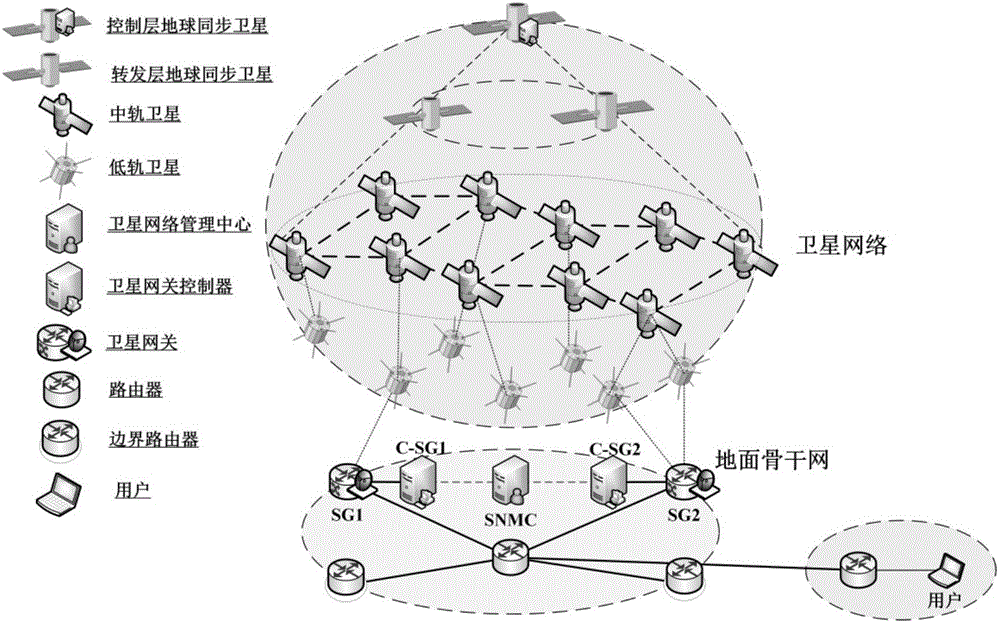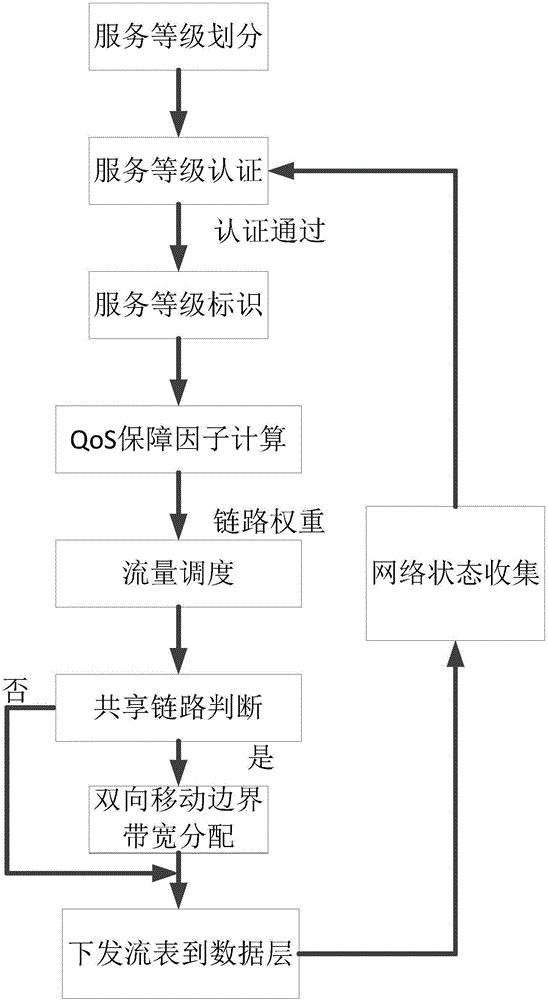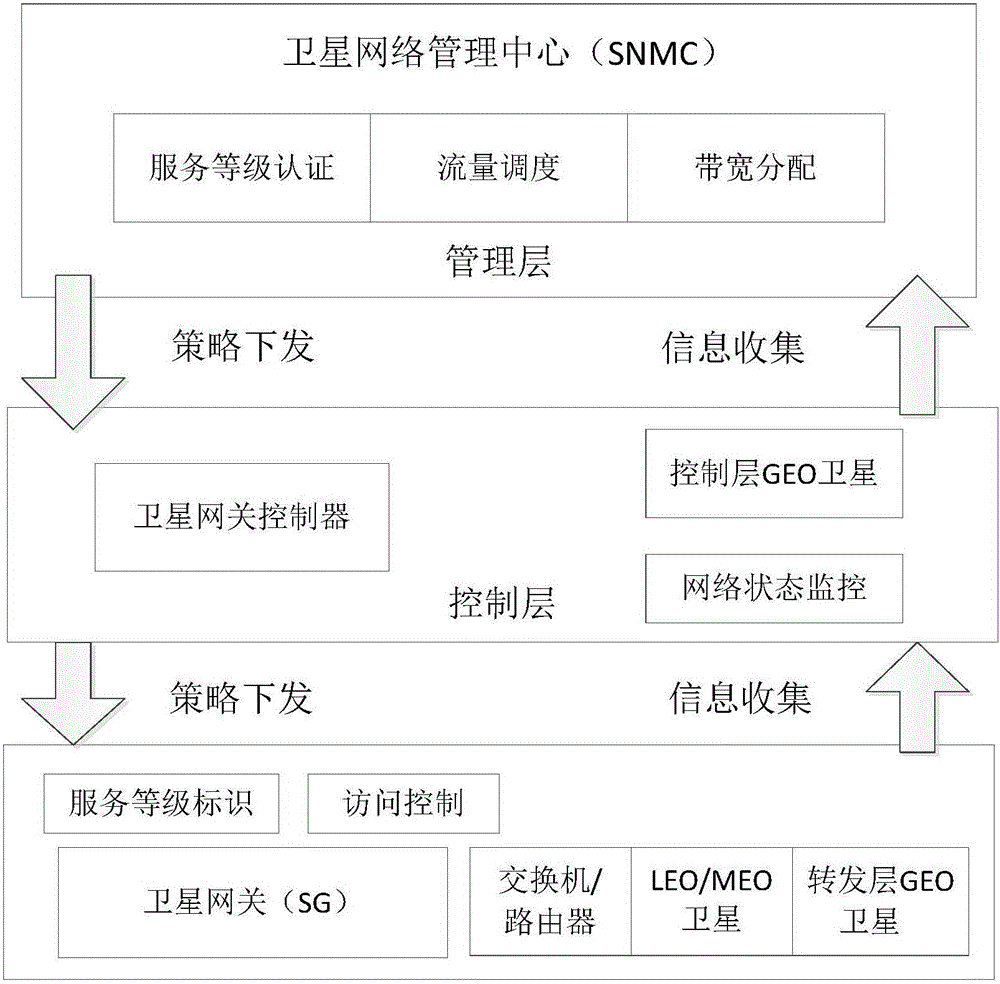Software defined network-based space network QoS guarantee method and management center
A software-defined network and space network technology, applied in the field of space network QoS guarantee methods and management centers, can solve problems such as inability to adapt to the complex environment of space networks, and achieve the effects of optimizing space resource allocation, low packet loss rate, and low delay
- Summary
- Abstract
- Description
- Claims
- Application Information
AI Technical Summary
Problems solved by technology
Method used
Image
Examples
Embodiment 1
[0102] Embodiment 1 of the present invention provides a software-defined network-based DTN traffic service level identification method, such as Figure 5 shown. First, select the available ToS value according to the DSCP Differentiated Services Code Point specified in RFC2474, and specify the optional ToS value set for each service level in SNMC. Taking CoS2 with a ToS value of 120 as an example, for traditional Ethernet data streams, it is only necessary to affix a label of ToS=120 on the traffic of user 1 at the satellite gateway. However, the present invention uses the ION platform that implements the DTN architecture to deploy a space network. In view of the store-and-forward mechanism of DTN traffic, the ToS label is cleared after passing through each ION node because the forwarding flow is regenerated. The solution process based on software-defined networking is as follows:
[0103] Step 1: User 1 sends a QoS request for the required service to SNMC, which is a real-ti...
Embodiment 2
[0112] Embodiment 2 of the present invention provides a software-defined network-based space network link status monitoring method. like Image 6 shown.
[0113] Step 1: The control layer GEO satellite sends a Packet-out message encapsulated with a delay detection frame to the data layer satellite, and records the time stamp t when sending 1 ;
[0114] Step 2: The data layer satellite forwards the delay detection frame to the adjacent data layer satellite according to the forwarding port specified in the Packet-out message;
[0115] Step 3: After the adjacent data layer satellite receives the delay detection frame, it does not know how to forward it, so it sends it to the GEO satellite with a Pacekt-in message; the GEO satellite receives the Packet-in message encapsulated with the delay detection frame, at this time Record the timestamp t 2 ;
[0116] Step 4: The GEO satellite sends a Stats-request message to the data layer satellite, and records the sent timestamp t 3 ;...
Embodiment 3
[0125] Embodiment 3 of the present invention provides a traffic scheduling method based on QoS guarantee factors, such as Figure 7 shown.
[0126]The user accessing from SG1 needs the space network to provide CoS1, CoS2 and CoS3 services of three different service levels for it and the peer user accessing from SG3. Assume that the bandwidth of the link between LEO-MEO layers is 6Mbps, and the bandwidth within the MEO layer is 4Mbps. The bandwidth requirement of CoS1 is 3 Mbps, the bandwidth requirement of CoS2 is 1.5 Mbps, and the bandwidth requirement of CoS3 is 2 Mbps, and the delay requirement of CoS2 is higher than that of CoS3.
[0127] SNMC first authenticates the CoS1 data flow with the highest priority, and calculates an optimal QoS path for CoS1, invokes the service level identification service in SG1, affixes the label tos_cos1 to the CoS1 data flow, and according to the calculation result of the traffic scheduling module, Send the forwarding policy to the data la...
PUM
 Login to View More
Login to View More Abstract
Description
Claims
Application Information
 Login to View More
Login to View More - R&D
- Intellectual Property
- Life Sciences
- Materials
- Tech Scout
- Unparalleled Data Quality
- Higher Quality Content
- 60% Fewer Hallucinations
Browse by: Latest US Patents, China's latest patents, Technical Efficacy Thesaurus, Application Domain, Technology Topic, Popular Technical Reports.
© 2025 PatSnap. All rights reserved.Legal|Privacy policy|Modern Slavery Act Transparency Statement|Sitemap|About US| Contact US: help@patsnap.com



